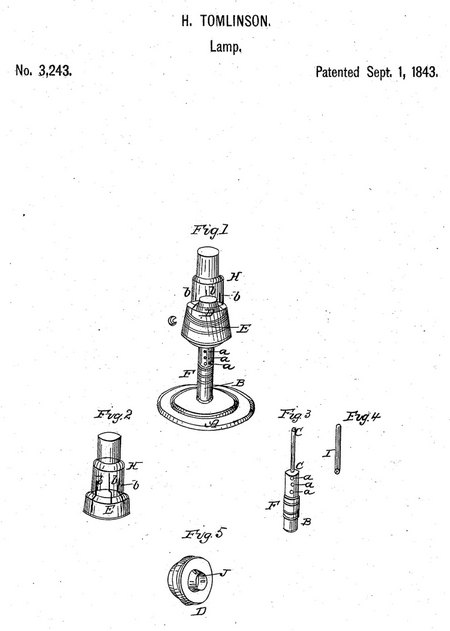Harvey Tomlinson
- Marriage (1): Mrs. Harvey Tomlinson in Geneva NY
General notes:
Pewtersmith
Events in his life were:

- He was issued patent number 3,843 on 1 Sep 1843
HARVEY TOMLINSON, OF GENEVA, NEW YORK.
LARD-LAMP
Specification of Letters Patent No. 3,843, dated September 1, 1843.
To all whom it may concern:
Be it known that I, Harvey Tomlinson, of Geneva, in the county of Ontario and State of New York, have invented an Improved Manner of Constructing a Lamp for the Burning of Lard, and other Concrete Fatty Substances; and I do hereby declare that the following is a full and exact description thereof.
My improvements in the lard lamp consist in the manner in which I attach a glass chimney or burner thereto and raise and depress the same, and in the manner in which I regulate the draft that passes through a central tube to supply air to the interior of the hollow wick.
In the accompanying drawing, Figure 1, is a perspective view of my lamp, from the bottom, A, of which rises a hollow stem, B, which has two, three, or more, holes through it for the admission of air, as shown at a, a, a.
C, is the body of the lamp, which I make conical, as shown in the drawing. Around this conical body passes a ring, or hook, E; to this ring I solder wires, b, b, b, which spring inward, and, by their elasticity, serve to support the chimney, or burner, H, at any desired height. The hoop, E, Avith the burner, H, attached to it, may be removed and replaced, at pleasure.
F, is a ventilating ring, or ferrule, which slides up and clown on the hollow stem, B, and may be made to close the whole, or a portion, of the holes, a, a.
Fig. 3, shows the hollow stem, B, having a hollow tube, c, c, rising above it, through which tube the air is to pass from the stem, B.
I, Fig. 4, is a wick tube, which should be made of copper; this is of such size as to slide freely over the tube, c, c, and its outside is to be covered with a hollow wick made of canton flannel, or of any suitable cotton fabric. The tube, I, serves to conduct the heat downward from the flame to the lard, or other fatty matter.
D, Fig. 5, is a cap, or cover, which shuts down within the body, C, of the lamp, and has a central perforation through it, at J, of such size as to admit the wick through its center.
When it is desired to carry a lamp of this kind about the house, the burner and ring, E, may be removed; its combustion will then be less vapid, and the light proportionally decreased. The light, also, may be decreased to any desired extent, while the burner is in place, as this may be depressed so as to be brought nearly, or quite, into contact with the cap, D, thus shutting off the exterior draft; and the ferrule, F, may be made to cover any number of the holes, a, a, thus shutting off any portion of the interior draft. The light may be thus reduced to that of a mere taper, furnishing an effective and convenient night light, the brilliancy of which may be increased almost instantaneously.
Having thus fully described the nature of my improvements in the lamp for burning lard, or other concrete, fatty substances, and shown the manner in which the same operates, what I claim therein as new, and desire to secure by Letters Patent, isó
The manner of regulating the draft thereof by the combined operation of the ventilating ring, or ferrule, F, and the shifting chimney, or burner, H; the respective parts being so formed and arranged as to operate in the manner herein fully made known; not intending, however, to limit myselif to the precise form of the parts as herein represented, but to vary these as I may think proper, while I attain the same end by means substantially the same.
Harvey Tomlinson
Witnesses:
E. P. Averill
J. W. Crawford
Harvey married Mrs. Harvey Tomlinson in Geneva NY.
|

